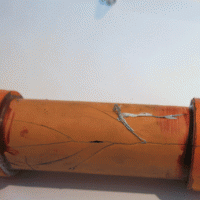The unusually severe 2014 winter in the eastern United States has reminded many people and businesses that when water in a pipe freezes, the ice will expand and burst the pipe or pipe fitting. Large losses will result from flooding when the temperatures rise. Insulation will help, but not prevent freezing. Insulation simply slows down the rate of heat loss. The time of exposure to subfreezing temperature is an important factor.
The American Society of Refrigeration and Air Conditioning Engineers (ASHRAE) Handbook of Fundamentals has a short entry on the topic (Chapter 23, page 23.5-6), which gives an equation for estimating the time that it will take an insulated pipe to freeze, given the pipe size, the amount and type of insulation, and the temperatures. A table is presented for various NPT sizes and insulation thickness, assuming an initial pipe temperature of 42 F, suddenly exposed to an ambient temperature of -18 F. For example, a 2” pipe with 1.5 inches of insulation (k=0.30 Btu-in/hr-ft2 –F) will freeze in 1.4 hours.
The above example is somewhat extreme, unless one lives in northern Canada; however, frozen pipes are experienced under less extreme conditions, even in southern states. The equation given can be used for other temperatures. The same pipe but with an ambient temperature of 20 F will take 4.6 hours to freeze.
Another limitation to the analysis presented in the ASHRAE Handbook is the assumption of sudden exposure to a low temperature (step change). A more common situation is that the ambient temperature decreases over a period of time. For example, when a hard cold front comes through, and/ or the house or building loses electrical power. The building will then cool down, but over a period of time. Ultimately the building temperature will equal the outside temperature. The only good thing about this situation is that the time to freeze the pipe will be significantly longer. The ambient temperature around the pipe will cool down, while the temperature of the insulated pipe will cool more slowly because of its insulation.
The analysis was reworked from the fundamental equation, but with the boundary condition of a linearly decreasing ambient temperature (Ref. Nellis & Klein, Heat Transfer, Cambridge University Press, 2009). Using the same example as above, and assuming that the ambient temperature (for example in the basement or attic) falls at a rate of 2o degrees per hour, then it will take 10.8 hours before the pipe begins to freeze. Maybe the heat will come back in before then!
There are many variables involved in this calculation, including the pipe type and diameter, the amount and type of insulation, the exact conditions of the pipe and location. Increased insulation for example increases the time to freezing. The rate of change of ambient temperature, particularly if it stops decreasing at an intermediate time (not as cold), will increase the time you have to get the heat back on. Also the calculation is conservative in that it does not take into account the time for latent heat removal from the water. The actual times stated would be slightly longer than quoted.
Warren engineers have the experience and expertise to investigate and determine the specific conditions of a frozen pipe loss, and establish cause.
Founded in 1997, The Warren Group, forensic engineers and consultants provides technical investigations and analysis of personal injury and property claims as well as expert testimony for insurance adjusters and attorneys. Extremely well versed in the disciplines of mechanical, electrical, chemical, structural, accident reconstruction and fire and explosion investigation, our engineers and consultants are known for delivering the truth — origin, cause, responsibility and cost of an event or claim — with unmistakable clarity.





